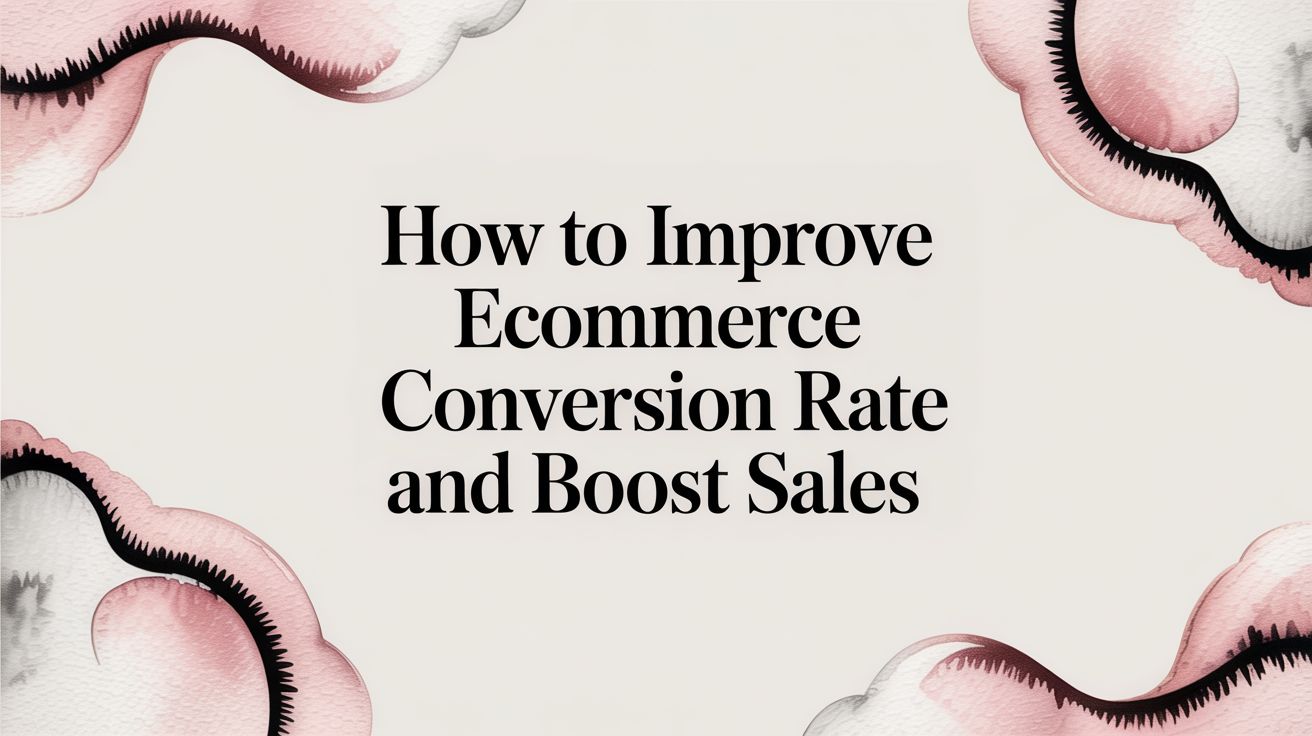
If you're running an e-commerce business, you know the daily grind. Juggling inventory, processing orders, managing customer service, and fighting chargebacks can feel endless. What if you could break free from that cycle and spend your time on growth instead?
Business process automation isn't about replacing your team; it's about freeing them from tedious, repetitive tasks so they can focus on what truly moves your store forward. It’s the key to working smarter and making your operations run smoothly. This list lays out the most significant business process automation benefits you can expect, from cutting costs to delighting customers.
We’ll cover ten clear advantages that can transform your daily workflow. You’ll see how automating key areas—especially tricky ones like chargeback disputes with tools like ChargePay—helps you reclaim valuable time, slash errors, and build a more resilient business. By the end, you’ll have a roadmap for how automation can become your secret weapon for scaling your e-commerce brand. We’ll explore everything from boosting operational speed and security to creating happier customers.
1. Increased Operational Efficiency
One of the biggest business process automation benefits is a huge boost in operational efficiency. It does this by taking over manual, repetitive tasks that eat up your team’s time. That frees your staff to tackle more strategic work, so you get more done without hiring extra hands. Automation keeps processes consistent every time, cutting down on mistakes and hold-ups.

For an e-commerce store, this means faster order fulfillment, quicker customer support replies, and smoother inventory updates. Instead of getting stuck on data entry or order processing, you can handle more sales with ease.
How to Implement It
- Map Your Workflow: Sketch out each step of your current process. Find the bottlenecks and repetitive moves that cry out for automation.
- Target High-Volume Tasks: Start with tasks you do all the time and follow clear rules—like invoicing or customer data entry. That’s where you'll see the biggest payoff.
- Measure Before You Start: Note how long tasks take now and how often errors pop up. That way, you can clearly track the gains once automation kicks in.
Automating critical functions—like chargeback management—can speed up dispute resolution and protect your revenue without any manual work. Learn more about how AI-driven automation streamlines this process. This proactive step not only saves time but also shields your bottom line.
2. Cost Reduction and ROI Improvement
Saving money is another major business process automation benefit. When you automate routine chores, you cut labor costs tied to manual work and slash expensive mistakes that lead to refunds or penalties. Automation also squeezes more value from your existing resources, so you get a better return on your investment. Research shows businesses can save 20–30% in areas they automate.
For an e-commerce merchant, that means less spending on data entry, customer support, and financial checks. For example, JPMorgan Chase saved over $300 million each year by automating contract reviews. Those kinds of savings let you reinvest in marketing, product development, or other growth areas.
How to Implement It
- Calculate Total Cost of Ownership (TCO): Go beyond the sticker price. Factor in software licensing, setup, maintenance, and support to see the full investment.
- Prioritize High-Cost Processes: Pinpoint tasks that are both frequent and costly when done by hand. Automating these first delivers the fastest ROI.
- Track Your Savings: Build a dashboard to keep an eye on key numbers—like reduced labor hours, error-related costs, and overall expenses—so you can measure the impact.
Automating financial workflows—like dispute management—cuts down on manual steps and helps you dodge steep fees. Get the details on the different types of chargeback fees and see how automation stops those losses. For a wider view, check out How End-to-End Product Optimisation Reduces Retail Operating Costs by cutting out tedious, manual work.
3. Enhanced Accuracy and Error Reduction
A big plus of automation is cutting down on mistakes. Manual tasks, especially repetitive ones like data entry or order processing, are prime spots for errors. One wrong digit or a typo can lead to missed shipments or bad financial reports. Automation follows set rules every time, ensuring consistent, precise results.

That accuracy builds trust in your data and workflow. For e-commerce, customer orders arrive correctly, inventory counts stay on point, and your books are solid. Catching small errors early stops them from snowballing into bigger, costly problems down the line.
How to Implement It
- Build Quality Checks: Sprinkle automated checks into your processes. For example, flag any address that doesn’t match expected formats before shipping goes out.
- Plan for Exceptions: No system is perfect. Decide how to handle any cases automation can’t process, then alert a team member to step in.
- Test Thoroughly: Run your new automation through plenty of scenarios to catch weak spots before you go live. That way, it works smoothly in the real world.
Automating chargeback responses means every piece of evidence gets submitted correctly and on time, which is key to winning disputes. A solid chargeback management system with AI isn’t just quicker—it’s more accurate than any manual process, boosting your revenue recovery rates.
4. Improved Compliance and Risk Management
Stronger compliance and risk control is another standout business process automation benefit. By building rules into your workflows, automation makes sure you always follow regulations and company policies. That cuts out guesswork and removes the human slip-ups that can lead to fines. Plus, you get a clear, auditable trail for everything.
For online stores, this means automatically handling customer data in line with GDPR or keeping payment processing up to PCI DSS standards. Enforcing compliance at each step protects you from penalties and builds customer trust.
How to Implement It
- Get Compliance Experts Involved: Work with your legal or compliance team early to make sure your automation reflects all the right rules.
- Document Every Rule: Clearly define each compliance check in your workflow. If you automate data deletion requests, for instance, the system must verify and log each action.
- Review Regularly: Regulations change. Schedule audits to update your automated steps whenever new rules come into play.
Automating these processes is a powerful way to avoid costly slip-ups—especially when it comes to payment disputes. Dive into a guide on chargeback risk management to see how automation keeps transactions safe and reliable. Staying proactive here is essential for protecting your revenue.
5. Increased Employee Productivity and Satisfaction
Freeing your team from dreary, repetitive tasks is a huge business process automation benefit. When you automate the mundane stuff, your employees can focus on creative, problem-solving work that really adds value. That shift turns them into strategic thinkers rather than data-entry robots.
For an e-commerce brand, your customer service team can build relationships and handle tricky issues instead of just processing returns. Your marketing folks can craft campaigns rather than hunting down data for reports. The result? A more motivated, happier workforce.
How to Implement It
- Share the Vision: Explain how automation helps your team, not replaces them. Show them how it cuts out the boring parts so they can tackle more interesting work.
- Offer Training: Give employees the skills to manage and optimize the new automated systems or move into more analytical roles.
- Include Their Input: Ask your team which tasks drive them nuts and should be automated first. Involving them in the process makes the new system more useful and boosts buy-in.
Automating tedious tasks like manual chargeback handling frees up your staff to drive growth. Discover how the right chargeback management tools lift the burden off your team so they can focus on high-impact activities. That translates to higher productivity and a happier crew.
6. Faster Decision-Making and Real-Time Insights
Automation gives you faster decision-making with real-time insights. Systems generate and process data as it happens, feeding you up-to-date reports and analytics. That way, you’re not guessing based on last week’s numbers—you’re acting on what’s happening right now.
For e-commerce, that could mean adjusting inventory levels on the fly or spotting fraud attempts the moment they pop up. Instead of waiting for a weekly report, you respond in real time—catching opportunities and stopping issues before they grow.
How to Implement It
- Connect Analytics Tools: Plug your automation into BI platforms like Power BI or Tableau to visualize trends.
- Build Key Dashboards: Create one-stop views showing sales trends, dispute rates, customer acquisition costs—whatever matters most.
- Set Up Alerts: Get notified when something needs your attention, like a sudden drop in sales or a spike in disputes, so you can jump on it right away.
Automating dispute management gives you a live view of chargeback trends and win rates. With ChargePay, you get an AI-powered dashboard showing which products or regions are triggering disputes, so you can tweak operations and keep more of your revenue.
7. Scalability and Business Growth Enablement
One of the most powerful business process automation benefits is that it grows with you. Automation handles more orders and complexity without you having to hire dozens of new people or buy tons of hardware. That means you can tackle holiday peaks, expand to new markets, or add product lines without breaking a sweat.

Imagine your store’s traffic surging 100x on Black Friday. With manual processes, your team would be swamped. Automation keeps orders, inquiries, and inventory updates moving smoothly, no matter the volume. That kind of reliability fuels growth and keeps you ahead.
How to Implement It
- Plan for Growth: When setting up automation, think big. Build systems that can handle 10x or 100x your current volume from day one.
- Go Cloud-Native: Choose cloud-based tools that automatically expand capacity as demand spikes—no sweat on your end.
- Keep an Eye on Performance: Monitor how automation handles increased loads so you spot any hiccups before they affect customers.
Growth also means more attempts at fraud and chargebacks. Automating dispute management with a solution like ChargePay makes sure you don’t lose revenue as your sales climb. It scales seamlessly with your business, protecting profits as you grow.
8. Better Customer Experience and Satisfaction
Automation can transform the customer experience, another major business process automation benefit. Faster service, consistent quality, and around-the-clock availability make shoppers happy. They get quicker replies, accurate orders, and personalized touches—all without waiting for a human to pick up.
For an e-commerce brand, this means chatbots handling routine questions instantly, or automated order updates keeping customers in the loop. That level of service breeds loyalty, positive reviews, and word-of-mouth buzz.
How to Implement It
- Trace the Customer Journey: Map every interaction, from browsing to post-purchase support. Find spots where automation can make things smoother.
- Go Omnichannel: Use automation across email, chat, and SMS so customers get a seamless experience no matter how they reach out.
- Plan for Human Hand-Off: Make sure your bots and automated messages can easily pass customers to a person when needed. That prevents frustration and shows you care.
Automating key pieces of the customer journey—from personalized marketing to a speedy checkout—can boost satisfaction and help you increase your e-commerce conversion rate. Investing in customer-facing automation is a powerful way to grow.
9. Enhanced Data Security and Risk Mitigation
Automation steps up your data security game, another big benefit. By cutting back on manual handling of sensitive info, you reduce the chance of human error causing a data breach. Automated systems enforce consistent controls and access rules, so data is always treated the way it should be.

For an online store, that means protecting payment details and personal data more effectively. Automated fraud detection flags suspicious transactions in real time—long before a person might notice. That kind of early warning is crucial for keeping customers’ trust and avoiding costly breaches.
How to Implement It
- Automate Access Controls: Grant or revoke system permissions based on roles, so no one has more access than they need.
- Use Automated Threat Detection: Deploy tools that watch your systems around the clock for odd behavior, then alert you or take action.
- Create Response Playbooks: Set up automated workflows that kick in when an issue pops up, ensuring a quick, consistent response every time.
When you manage chargeback disputes, automation ensures sensitive documents and payment info stay in a secure, compliant environment. That extra layer of protection keeps both your customers and your reputation safe.
10. Competitive Advantage and Strategic Differentiation
Automation can set you apart in your field, giving you an edge few manual operations can match. By automating strategic workflows, you free up resources to try new features, improve the shopping experience, and innovate faster. That agility makes your store stand out and helps you stay on top over the long haul.
Amazon uses automation to get orders out the door faster and cheaper. Netflix’s recommendation engine keeps viewers hooked. Tesla’s robots crank out cars at record speed. These brands show how automation can carve out a clear advantage.
How to Implement It
- Identify What Sets You Apart: Pinpoint the processes that matter most for customer happiness and speed.
- Roll Out in Phases: Start with one high-impact area—like personalized emails or dynamic pricing—and expand from there.
- Leverage AI and ML: Bring in learning models to fine-tune recommendations, forecasts, and fraud detection.
- Track Your Wins: Watch metrics like order cycle time, repeat purchases, and cart abandonment to see your progress.
- Celebrate Success: Share your automation wins in newsletters or social channels to build credibility and momentum.
When you weave automation into your growth plan, routine tasks become a launchpad for fresh ideas. Discover how ChargePay’s AI-driven automation helps you gain and keep that essential edge at https://www.chargepay.ai.
Business Process Automation — 10-Benefit Comparison
Putting Your E-Commerce Business on Autopilot
As you’ve seen, automation is more than a buzzword—it’s a game changer for e-commerce. It’s not just about saving time; it’s about building a smarter, more adaptable, and more profitable store. The business process automation benefits we’ve covered—from slashing costs to boosting security—all point to one thing: giving you the freedom to focus on what matters.
Every minute spent on manual data entry, tracking inventory, or compiling reports is time you’re not spending on marketing, product development, or customer care. Automation reclaims that time, turning your daily grind into a smooth-running engine in the background.
From Theory to Tangible Results
Getting started might feel overwhelming, but it begins with one simple step: spotting the tasks that eat the most time, cause the most errors, and repeat the most.
Here’s a quick recap of how automation impacts your bottom line:
- Efficiency and Savings: Automation tackles your biggest operational drains, doing the work of multiple hires in a fraction of the time without errors. That means lower overhead and healthier margins.
- Accuracy and Compliance: From fulfilling orders to financial reporting, automation makes sure every detail is spot-on. That precision protects you from costly mistakes and keeps you on the right side of regulations.
- Scalability and Growth: You can’t grow if you’re bogged down in the weeds. Automation gives you a foundation that handles order surges without adding headcount, making expansion seamless.
- Team and Customer Happiness: By freeing your team from drudgery, you empower them to do more engaging, strategic work—boosting morale. That positive environment translates into faster, more reliable experiences for your customers.
Chargeback management is one area that often gets overlooked but offers huge gains when automated. Manually fighting disputes can drain resources, frustrate staff, and chip away at your revenue. That’s exactly where targeted automation shines.
Key Takeaway: Automation isn’t here to replace people—it’s here to remove repetitive friction so your team’s real talent can drive innovation and growth.
Automation is no longer just for the big players; it’s a must-have for merchants of any size. By weaving automated systems into your operations, you’re not just tweaking a few processes—you’re building a more nimble, future-ready business from the ground up.
Ready to see one of the most powerful business process automation benefits in action? Stop losing revenue to chargebacks and let ChargePay handle the entire dispute process for you with our industry-leading AI. Sign up today and put your chargeback management on complete autopilot.







.svg)







.svg)
.svg)
.svg)